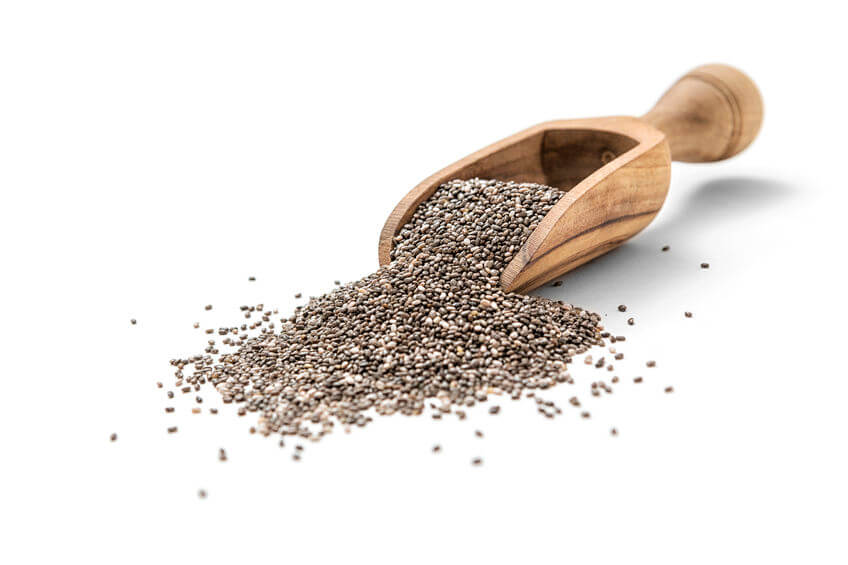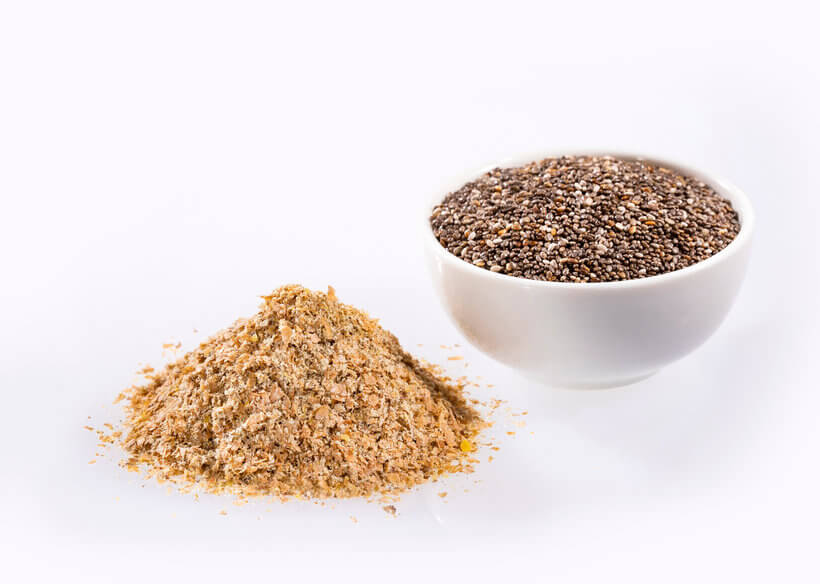Chia seeds are the edible seeds from the Salvia Hispanica flowering plant. Intact, they have an oval shape and are fairly tiny at about two millimeters long. Many people like to use this plant in a variety of ways but one of the common questions is whether there’s a difference between chia meal vs chia seed. To get a better understanding, it may be helpful to understand the specifics of each.
Chia Meal VS Chia Seed: What Are They?
Chia seeds and chia meal are the same type of seed but simply in different forms. Chia seeds are the intact seed:

They appear to be fairly small grains and can be eaten as-is or used in a variety of different ingredients. The seeds will absorb fluid and can be kept in a cool, dry place usually for years without spoiling.
Chia meal is similar to the intact seed but instead it has been ground finely to form a powder or a flour-like substance:

This is possible to do on your own. Simply add the seeds to a coffee grinder or similar spice grinder and grind until smooth.
The ground up meal can also be stored in a cool, dry place or kept in a fridge or freezer.
The meal is more prone to becoming rancid and will spoil more quickly than the intact seed. People who make their own chia meal often only grind up what they’re about to use.
What’s The Difference?
When comparing chia meal vs chia seed, the primary difference is simply the size of the seed itself. The intact seed will take longer to absorb water or fluid while the ground seed will go through this process faster.
Many people may think that the ground up meal will improve the nutrition or the absorption of the chia seed. This can be true for some other seeds like flax seeds. Flax seed has a tough hull and grinding it allows the omega-3 fats to be more easily digested and absorbed.
In contrast though, chia seeds do not have this tough outer shell. There is not a significant nutrition or absorption difference between the two seeds.
How To Use Each
What may make a larger difference when comparing chia meal vs chia seed is how you use them. Although they have similar nutrition and benefits, you may find that certain uses are best for the chia powder rather than the intact seed.
Chia Meal
When using the ground chia seeds, it’s a great addition to any recipe that uses flower. You can add heart-healthy fiber to cakes, muffins, breads and more when using chia seed flower. Since the chia seed is high in fiber, start off by using a small amount.
They also make a perfect natural thickener to soups and sauces. Although you can use the entire seed, the ground meal is going to allow the thickening to happen much faster. Also, people will likely not even realize that chia meal has been used.
Other simple recipe ideas for the ground seeds include chia seed pudding, chocolate chip cookies, and egg substitute for vegan-friendly recipes. Finally, chia powder can be used as a thickener for jams or jellies.
Chia Seed
The intact chia seed is going to have a slightly crunchy nutty flavor and it’s best to take advantage of this when adding to recipes.
You can also include the intact seeds in recipes but the texture of the whole seed may not work as well.
Dry chia seeds can be added as a simple addition to yogurt and oatmeal or sprinkled on top of a salad. It’s a common topping for smoothie bowls as well. Adding the seeds to these foods will allow them to swell up slightly but they’ll still have a crunch.
Health Benefits Of Each
The health benefits of chia meal vs chia seed are not significant according to studies.
Grinding up the seeds may improve some absorption of nutrients but it’s unlikely that this will have a significant difference for the average person. Instead, focusing on getting the seeds into your diet will have the biggest impact.
One of the primary health benefits of chia is it’s rich source of omega-3 fatty acids. In both human and animal studies, these fatty acids have been shown to have a significant effect on heart health. They work to regulate heart rate, lower blood pressure and lower cholesterol (source).
The fiber in the seeds is primarily soluble fiber. When consumed on a regular basis, soluble fiber may help to lower LDL or “bad” cholesterol and slow down digestion. This allows foods to be digested slowly, and it makes both chia meal and chia seed great natural alternatives to products like psyllium husk.

Having the seeds in your diet can also benefit anyone interested in losing weight. Since they are chock full of fiber and slow down digestion, people will notice that they feel fuller after eating a meal or snack that contains chia seeds. The seeds will promote satiety after a meal and decrease the absorption of sugar into the bloodstream. This allows you to feel and remain full for a longer period of time.
With decreased feelings of hunger between meals, chia seeds can contribute to weight loss, especially when consumed as part of a healthy lifestyle.
Nutrition
Finally, chia seeds are a good source of nutrients. Just two tablespoons of chia seeds contains 138 calories and almost 5 grams of protein. However, the seeds also contain almost 10 grams of fiber, and essential vitamins and minerals such as magnesium, phosphorus, iron, thiamine, and niacin.
Having just two tablespoons of chia seeds can improve your intake of essential nutrients. When comparing the nutrition content of chia meal vs chia seed, there’s not much difference. Anyone concerned with absorption though may want to try and get the chia meal.
In Summary
Regardless of whether you use the chia meal or intact seed, it’s no surprise that this small seed is known as a superfood. The benefits of each are numerous and plentiful.

